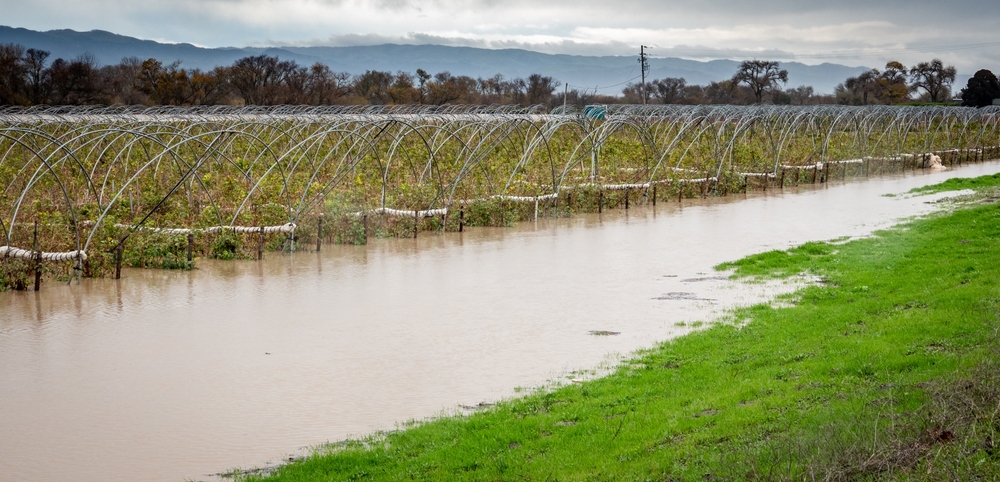While the state assesses agricultural damage from a historic deluge, official tallies may overlook an important segment of the industry.

For Manuel, an orchard worker in California, this should normally be a busy time of year. The Fresno County resident, who declined to give his last name due to his immigration status, usually spends January pruning pistachio trees on farms throughout the San Joaquin Valley.
But the past few weeks have been anything but normal. Atmospheric rivers have raged across California for nearly a month, unleashing torrential storms with more than six times the normal volume of precipitation in many parts of the state, with some estimates putting the rainfall at more than 24 trillion gallons.
“The fields are completely flooded. They’re all filled with water and mud,” says Manuel, speaking through an interpreter provided by United Farm Workers (UFW). With vehicles unable to access farmland and orchards, employers have repeatedly turned away workers, he adds, and he hasn’t had a paycheck in four weeks.
As California slowly surfaces from a historic deluge, the state is coming to grips with the sobering extent of the damage left in its wake. The impacts have hit the agricultural industry particularly hard; in Monterey County alone, initial estimates put losses in the region at nearly $50 million, including upwards of 35,000 flooded acres and damage to equipment, farm infrastructure and crops.
But for farmworkers and small-scale growers, advocates say that official tallies overlook the hard-to-quantify costs of hardship and inequity brought on by extreme situations. Along with losing wages during inclement weather, few have adequate access to property and crop insurance, emergency relief or government assistance. As a result, many are left relying on a thread-bare safety net—one already weakened by the state’s seemingly endless cycle of challenges.
“Those are the hidden costs that we don’t always think about,” says Evan Wiig, director of communications at the non-profit Community Alliance with Family Farmers (CAFF), when assessing the impact of disasters.
At San Francisco’s bi-weekly Heart of the City Farmers’ Market in mid-January, a break in the latest string of storms brought out an eager crowd of shoppers. But of the 48 farm booths, Steve Pulliam, the market’s executive director, estimates that a third were absent. He’s made contact with several who report damage to fields, property and equipment.
For Rudy Jimenez, owner of Green Thumb Organics in San Benito County, it was business as usual, despite flattened greenhouses and half of his five-acre farm still underwater. “We lost our crops—a lot of broccoli, cauliflower, Brussel sprouts—that were just coming into season,” he says, adding that the replanting, repairs and cleanup will set them back by six months.
Mario Diaz of Paoletti Farms, located in the San Joaquin Valley, reported 25 acres of flooded orchards and fields. During pauses in the storm, the farm tasked workers with digging holes to drain water-logged groves to keep roots from rotting. It provided them with much needed work, he says, as “we can’t afford to pay them when the weather’s too bad.”
Their nut and stone fruit orchards seemed to have fared well, he notes, and should be flowering soon absent further downpours. But, as for their field crops, “they’re all just ruined.”
The market has lost 27 farmers and food vendors to the successive events of the past three years. “We used to have a waiting list,” says Pulliam. “But these guys have gone through wildfires, droughts, COVID,” and mounting challenges such as inflation and the high cost of labor make it tougher for small-scale growers to stay afloat. Missing even a few market days, he says, can seriously impact their bottom line.
Small-scale farmers also tend to be less protected against crop failure, says Michael Yang, a small farms and specialty crop advisor for University of California Cooperative Extension. Many minority growers, particularly in the Central Valley, cultivate niche and ethnic produce for which insurance coverage is simply non-existent.
“Specialty crops like lemongrass and bitter melon aren’t even on the list [of insurables],” he says. And because farming a diverse mix of fruits and vegetables on small acreages can make for an actuarial mess, small farmers are often likely to forgo crop insurance altogether.
In fact, farms can face coverage restrictions regardless of size. David Vierra of Vierra Farms recently lost 150 acres of winter wheat he had planted in the northern reaches of the Sacramento-San Joaquin River Delta. Although crops planted in floodplains are uninsurable, it seemed like a safe bet given the drought. “It was a pure gamble,” he says, “and it didn’t work out.”
Fortunately, the damage constitutes a small part of Vierra’s 4,000-acre operation, but small-scale growers take a much greater financial risk when farming in floodplains. With fields throughout Fresno County currently “looking like pools,” farmers face a tough year ahead, says Yang, and consumers will likely see “less choice, less supply and probably higher prices.”

Flooding in Northern California. Photography by Shutterstock.
Disaster relief, when available, can be difficult to access and slow to materialize, says CAFF’s Wiig. For instance, the USDA Farm Service Agency (FSA) is currently accepting applications for emergency relief—for natural disasters that occurred in 2020 and 2021. Small operations may not have the resources to wait out long payout periods, he says.
Applying for government programs can also be overwhelmingly onerous. “The amount of paperwork required for 600 acres of almonds is the same as what you need for a quarter-acre of arugula,” says Wiig. For small-scale farmers who plant a mix of crops, trying to plug a complex, dynamic and versatile farming system into an application designed for large commodity farming “just doesn’t fit.”
The laden process can discourage farmers of color, immigrants and those who lack the resources to navigate the bureaucratic process from applying, says Wiig. And, in most cases, undocumented farmers are flat-out ineligible.
Last week, CAFF announced its own emergency fund—a relaunching of a program previously set up for wildfire, drought and pandemic relief. Funded mainly through donations, it’s open to all California farmers, regardless of immigration status, with grants of up to $10,000 covering a range of disaster-related needs.
“We try to seek out those who don’t have insurance or a safety net,” says Wiig, noting that grants are typically approved and distributed within a month. Undocumented farmers—many of whom quietly supply California’s farmer’s markets, food hubs and pantries—are also “prioritized above all,” he adds, given their lack of access to other resources.
Farmworkers face a similar, if not more precarious situation, says Antonio De Loera-Brust, UFW’s communications director. Along with losing multiple weeks of income due to weather, large numbers of them have experienced flooding in their homes and towns.
Their communities are often clustered in rural, unincorporated towns such as Planada, which recently made headlines after massive inundation forced a large-scale evacuation. With few resources and no city government to provide direct support, “these are the people most impacted in terms of property damage,” says De Loera-Brust.
Given California’s high number of undocumented farmworkers—estimated at around 75 percent—many of the affected are ineligible to receive FEMA disaster funds, unemployment or other government assistance, despite paying taxes. “Even though they’re essential to our economy, they’re a very vulnerable workforce, usually living at or barely above the poverty line,” says De Loera-Brust.
He pointed to a video of poncho-covered workers rapidly harvesting celery under heavy storm clouds on a Ventura County farm. Those who have been able to find work in the rain continue to do so, says De Loera-Brust, even in cold, wet and dangerous conditions.
It’s typical to endure bad weather and work, even after getting sick or injured on the job, says Manuel, the orchard worker. “We all have to make ends meet,” he adds, so farmworkers tend to keep a low profile and simply carry on.
Meanwhile, with clear skies finally on the horizon, Manuel is hopeful that cleanup work will begin as soon as flooding subsides. “I also hope that the government can pass some sort of immigration reform to give people [like us] work permits,” he says. “We work hard and many of us have been here for a long time. So, in the future, maybe we can get some government assistance in situations like this.”
Yeah, just wish we could have saved more of that water. Way too much went into the ocean.